|
Tick Tock Toys
by Bob Brooke
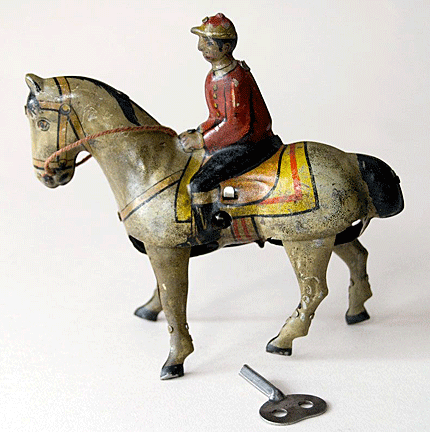 Long
before video games and battery-powered toys, kids needed to be
entertained. Back in the 19th and early 20th centuries, it was
clockwork toys that helped keep them amused. Long
before video games and battery-powered toys, kids needed to be
entertained. Back in the 19th and early 20th centuries, it was
clockwork toys that helped keep them amused.
Today, nearly all toys are battery-operated. But before the 1980s,
toys relied on windup power and clockwork mechanisms. The earliest
clockwork device, known as the Antikythera mechanism, dates from
ancient Greece.
In clockwork toys, power is stored in a spring governed by an
escapement, a mechanism in a clock that connects and regulates the
motive power, originally invented for clocks. The term clockwork has
often been used inaccurately to refer to all spring-driven toys. The
difference between clockwork in clocks and that in toys is that the
pendulum in clocks makes the mechanism turn very slowly while toys
need it to turn quickly. The pendulum governor is replaced with a
fly fan.
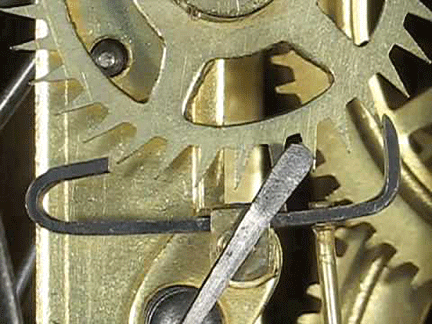 Clockwork
escapements allow one tooth at a time to escape from the pallet at
regular intervals in order to keep springs from springing. The
pallet rocks back and forth, governed by a pendulum or an
oscillating piece. Clockwork
escapements allow one tooth at a time to escape from the pallet at
regular intervals in order to keep springs from springing. The
pallet rocks back and forth, governed by a pendulum or an
oscillating piece.
Another form of governor, instead of an oscillating piece, is a
fast-moving small weight in cheaper wind-up movements. The pallet,
itself, constitutes the rapidly clicking pendulum. In walking figure
toys, the toy acts as the oscillating pendulum.
Cheap mass-produced wind-up toys weren’t in any sense clockworks.
Simply springs with gears and a crude oscillating pallet for a
governor.
 Those
with rocking hands and beckoning arms are called nodders. Clockwork
nodders were basically simple clocks without dials. A nodder uses a
horizontal compound pendulum with the head as the weight at one end,
a counterweight inside the body at the other end and the pivot at
the neck. It’s activated by an ordinary clock escapement. Those
with rocking hands and beckoning arms are called nodders. Clockwork
nodders were basically simple clocks without dials. A nodder uses a
horizontal compound pendulum with the head as the weight at one end,
a counterweight inside the body at the other end and the pivot at
the neck. It’s activated by an ordinary clock escapement.
Like an old-fashioned clock, a clockwork device is completely
mechanical and has these essential parts:
―A spiral spring to store the energy
added by winding a key.
―A set of gears through which the spring's energy is released. The
gears control how quickly (or slowly) a clockwork mechanism can do
things.
―In a clock, the mechanism is the set of hands that sweep around the
dial to tell the time. In a clockwork car, the gears drive the
wheels that
power it over the floor.
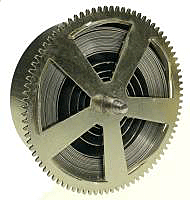 When
you turn the key, you're tightening a sturdy metal spring, called the
mainspring, and storing up energy; the mainspring is the mechanical
equivalent of a battery. Clockwork springs are usually thick twists of
steel, so tightening them is hard work. With each turn of the key, the
spring is compressed. A cylindrical box called the barrel with gear
teeth around its edge contains the tightly wound spring. The longer and
thinner the spring, the more energy it can hold inside a barrel of a
certain size. When
you turn the key, you're tightening a sturdy metal spring, called the
mainspring, and storing up energy; the mainspring is the mechanical
equivalent of a battery. Clockwork springs are usually thick twists of
steel, so tightening them is hard work. With each turn of the key, the
spring is compressed. A cylindrical box called the barrel with gear
teeth around its edge contains the tightly wound spring. The longer and
thinner the spring, the more energy it can hold inside a barrel of a
certain size.
Tightening the mainspring in a windup toy is like pushing a
rollercoaster car up a hill. Just as a rollercoaster car regains energy
by rolling down a hill, so the energy returns from a mainspring by
releasing it to drive a clockwork mechanism. The longer a clockwork toy
is to operate, the more energy it needs.
Virtually all clockwork devices have gears, which are wheels with teeth
that mesh together that make a wheel go faster with less force or slower
with more force. Clockwork mechanisms use gears in both these ways.
Clockwork toys use the mainspring to generate rotational power—to turn
wheels. To make them do something other than turn, roll, or rotate, a
cam or crank is needed to transform their rotational motion into
back-and-forth motion.
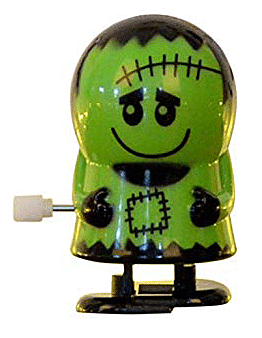 When
you see a clockwork robot walking along, it's probably using cranks
driven by wheels to power its legs. The wheels rotate on the same shaft,
at the same speed, driven by gears powered from the mainspring, and each
leg is connected to the leg by a separate crank. One leg will be
connected to the top of one of the wheels, while the other leg will be
connected to the bottom of the other wheel. As the two wheels turn, the
cranks will move around out of step and the two legs will connect with
the ground alternately, making the robot shuffle along. When
you see a clockwork robot walking along, it's probably using cranks
driven by wheels to power its legs. The wheels rotate on the same shaft,
at the same speed, driven by gears powered from the mainspring, and each
leg is connected to the leg by a separate crank. One leg will be
connected to the top of one of the wheels, while the other leg will be
connected to the bottom of the other wheel. As the two wheels turn, the
cranks will move around out of step and the two legs will connect with
the ground alternately, making the robot shuffle along.
Designers of clockwork toys always need to know beforehand what the they
want the toy to do and the surfaces they’ll operate on. Then they have
to choose a spring that can store enough energy to keep the mechanism
working for a while.
Only a small group of American toys actually operated with clock
mechanisms. Generally, keys and cranks, that activated small springs
which turned tinplate gears when released, powered wind-up toys.
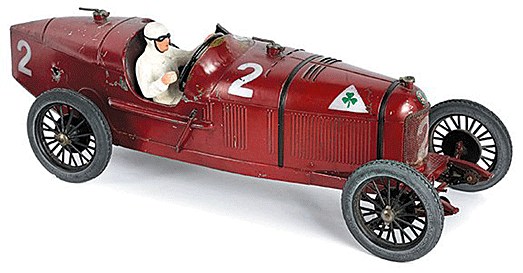
Mechanical parts were often hidden in the toy’s widest section or base,
and extended motion to appendages via wires or springs. For example, a
toy carriage typically propelled its miniature horse, rather than the
other way around. Some toys made use of weighted flywheels, whereby a
pulled string or lever used the inertia of a weighted spring to create
movement.
Early Clockwork Toys
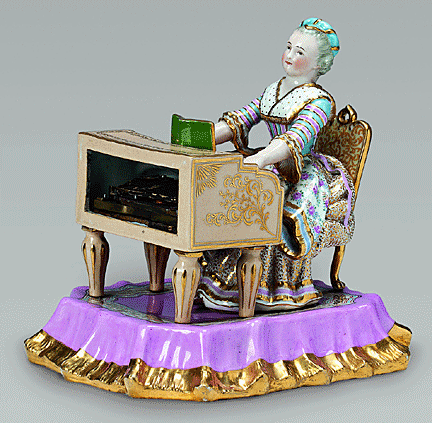 Craftsmen
made the earliest clockwork toys for wealthy European aristocrats, like
the detailed battle scene made for the Dauphin of France around 1660.
That toy featured charging cavalry and realistic explosion sounds. These
types of clockwork toys became popular after Jacques de Vaucanson
exhibited his human automatons in Paris in 1738. Among his more haunting
figures was a kid-friendly clockwork duck, which could eat, drink,
quack, and swim. Craftsmen
made the earliest clockwork toys for wealthy European aristocrats, like
the detailed battle scene made for the Dauphin of France around 1660.
That toy featured charging cavalry and realistic explosion sounds. These
types of clockwork toys became popular after Jacques de Vaucanson
exhibited his human automatons in Paris in 1738. Among his more haunting
figures was a kid-friendly clockwork duck, which could eat, drink,
quack, and swim.
Beginning in the 19th century, toy makers like Lucien Bontemps in Paris
began producing affordable versions of these wind-up toys. Bontemps’
wind-up character dolls typically performed demure movements to the
tinkling of music boxes hidden beneath their bases. However, he designed
these complex toys as adult novelties rather than children’s playthings.
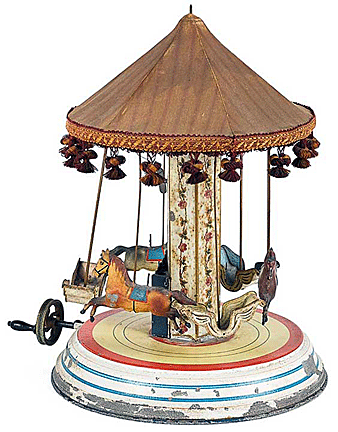 By
the late 1800s, toy makers began to create simpler wind-up models, made
from painted tin, just for children. These figural toys ran for only a
few minutes, but still performed highly specific tasks like climbing a
ladder or writing a letter. To make products more cheaply, manufacturers
used materials like cardboard, composition, and tin instead of expensive
porcelain or wax. By
the late 1800s, toy makers began to create simpler wind-up models, made
from painted tin, just for children. These figural toys ran for only a
few minutes, but still performed highly specific tasks like climbing a
ladder or writing a letter. To make products more cheaply, manufacturers
used materials like cardboard, composition, and tin instead of expensive
porcelain or wax.
Racing horses, carousels, bicycling figures, and even wobbling drunks
suddenly came to life on playroom floors. Many late-Victorian toys
reflected the social and political climate of the day, modeling scenes
from current events like the Dreyfus Affair. Circus-themed toys were
also common, from acrobatic clowns who appeared to walk on their hands
to trapeze performers that spun in mid-air. The French firm Fernand
Martin and the German company Lehmann became some of the most prolific
designers of these miniature automata, cutting figures from sheet iron
and assembling them using small tabs and slots.
American clockwork toys first appeared around 1860. Toy makers often
fashioned them using the exact same style movements used to turn the
hands of clocks.
George Whitfielld Brown, a clockmaker from Forestville, Connecticut,
began producing toys as a sideline of clockmaking in 1854. He made the
first mass-produced clockwork toy in 1856.
The first American patent, granted on August 6, 1861, was for a toy
motor to work feet invented by E.R. Morrison. The clockwork mechanism
lifts each foot alternately as the other foot pushes it forward.
The firm of Ives and Blakeslee dominated the American toy scene for
several decades.
In 1880, Secor’s Stationery, owned by Jerome Secor, advertised singing
birds called American Warblers. His company also made cannon and toy
pistols with clockwork movements. Owner Jerome Secor used cast iron for
his toys. He designed the first cast-iron clockwork locomotive.
The Secor Bridgeport Toy Company was located in a factory owned by
Edward R. Ives, who began making hot air toys in 1866, then moved his
operation to Bridgeport, Connecticut four years later.
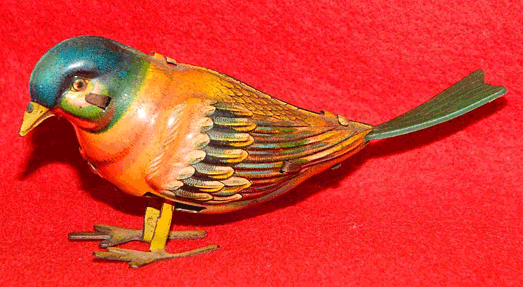
Ives produced a lithographed tinplate singing bird. Though only the size
of a small thrush, it had an internal clockwork drive that drove a
remarkable array of mechanisms. A piston and bellows blew a tiny flute
similar to a Suwannee Whistle—a 19th-century bird whistle. A cam moved
the stop to vary the notes of the song. Other levers made the bird flap
its wings and tail, turn its head, and open and close its beak. Ives
also made less complicated clockwork toys, including a woman churning
butter.
Mass-Production Comes to Toys
The Industrial Revolution turned toy making into big business.
Manufacturers began making toys with cheaply produced spring-driven
gears with crude escapements instead of elaborate clockwork movements.
Most of the U.S. toy companies were located in the Northeast, especially
Connecticut, and included George Brown, E.R. Ives, Blakeslee & Company,
Martin & Runyon, Automatic Toy Works, and Louis Marx & Company. Within
three decades, they discontinued making clockwork toys as cheaper
European wind-ups flooded the U.S. market.
<
Back to More Antique Spotlights
Next Article >
|
